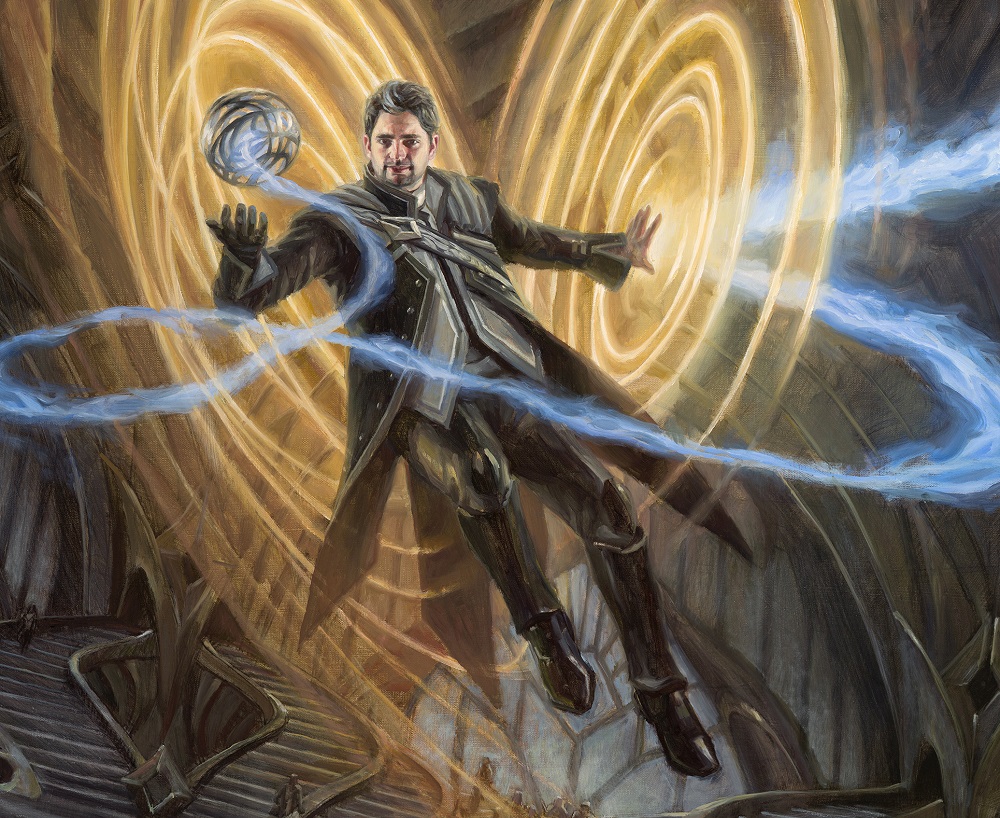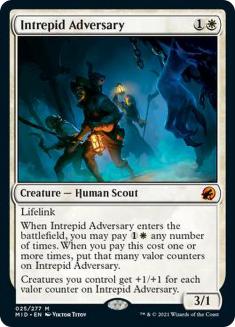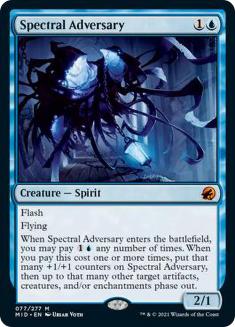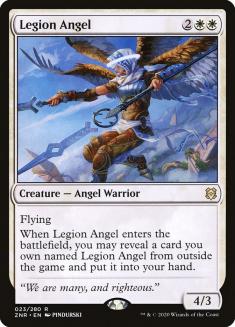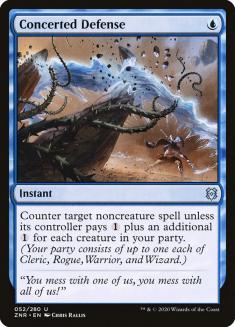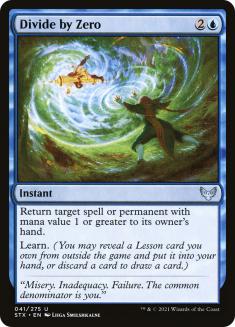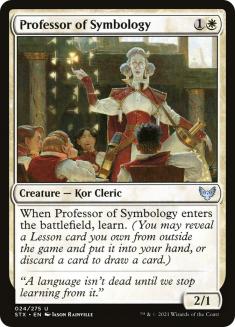Somehow, the leak of the Magic World Championship XXVII decklists feels like business as usual. Rather than point out the obvious lack of care one would expect with their marquee tournament, I’d rather lean into an unexpected opportunity. Having access to the decklists early means we have more to talk about leading into the event. If anything, it will make me more invested in the tournament that I otherwise would have been. I’m not thrilled about how it affects the integrity of the event, but there’s nothing to do about that now.
Out of the entire field, Noriyuki Mori’s deck stood out to me the most.
Creatures (25)
- 2 Legion Angel
- 4 Luminarch Aspirant
- 3 Reidane, God of the Worthy
- 4 Elite Spellbinder
- 1 Loyal Warhound
- 1 Brutal Cathar
- 4 Spectral Adversary
- 4 Intrepid Adversary
- 2 Malevolent Hermit
Lands (10)
Spells (25)

Having all the decklists leak four days early potentially gives the competitors time to practice against their opponent’s specific decklists if they wanted to. For someone like Mori, part of the advantage of playing a deck off the beaten path is that his opponent’s wouldn’t have practiced against him. The leak disproportionally hurts him, possibly more than anyone else in the entire field. That said, Mori likely registered the deck because it has solid matchups against Izzet Epiphany and Mono-Green Aggro❄ and not because of the surprise factor. Hopefully it won’t penalize him very much.
At its core, this Azorius decklist from Noriyuki Mori is a classic aggro-control or tempo deck. You want to get a threat or two onto the battlefield early and then protect them. Mori’s deck does a fantastic job of executing that plan with its cheap threats, one-mana interaction, and tricky gameplay.
This is a deck that often wins by inches. There are some games where you stick a couple threats, counter a couple spells, and your opponent can’t recover. In most games, you’re fighting for tiny edges, trying to get as much use from each mana spent as you possibly can. Each game can feel like a rollercoaster.
As I’ve mentioned, there are very few comeback mechanisms. Against Mono-Green Aggro❄ and Izzet Epiphany, that’s not the most relevant concern. In an open field, where players might be playing aggro decks with one-drops, it’s significantly more relevant. Mori’s deck is specifically designed for a small field where he knew the field would primarily consist of the two most popular decks. If the field were larger, like a Pro Tour or Mythic Championship, then I doubt he would have registered the same deck.
Noriyuki has even talked about taking such approaches and their potential downsides on his blog.
Taking a gamble like that in a small field could pay huge dividends, especially if your predictions end up being correct. Mori’s deck is hard targeting Izzet Epiphany and Mono-Green Aggro❄, which is mostly what the field consists of. As he noted, you can tune a deck, prepare it for certain matchups, and still have it end up being too weak to play.
Deckbuilding
Mori doesn’t bother with one-drops because they don’t stand well on their own. Having a plethora of one-drops can matter, but his deck is trying to be attacking with only a threat or two at a time, so he needs those threats to be able to carry enough weight by themselves. He seems to have selected the right threats for the job.
Intrepid Adversary is somewhat awkward in the deck because it doesn’t go very wide. Still, it’s a two-drop that trades with Werewolf Pack Leader, has enough power to pressure Izzet Epiphany, and gives you a life buffer for winning races. It’s probably the weakest link in the entire deck, but there isn’t an obvious replacement.
Spectral Adversary is nice when you’re trying to hold open Fading Hope or Concerted Defense. Mostly, I’ve used it as a two-drop and that’s been good enough, but there are also a few different tricks you can use it for. You can win races by removing attackers or blockers. I’ve also used it to phase out treasure Tokens during my opponent’s upkeep to keep them low on mana for the turn. It can also protect your relevant threats from removal spells.
One of the best things about Spectral Adversary was being able to transform Brutal Cathar while still developing your battlefield. There are very few decks that are better at utilizing Brutal Cathar than this one.
Legion Angel is surprisingly important to this deck. It has a low mana curve and, despite having mana sinks with the Adversarys and creature-lands, the deck is often starving for ways to spend its mana. A single Legion Angel represents twelve mana to spend, which hopefully gives you enough to do until the game ends. Its inclusion is important.
In theory, Concerted Defense is poised to be incredible. Most of that hinges on keeping a party member or two on the battlefield, which is sometimes easier said than done. There are eight Clerics, two Wizards, and two Warriors, which isn’t a massive amount. Unfortunately, some of the newer creatures don’t have a party affiliation, otherwise I’d be much happier with this deck.
Mori only plays two Deserted Beach, despite having very few one-drops. His deck would also appreciate the extra dual land. I’ve been stuck on three Islands and one Plains enough times to strongly consider more Beaches. Fourteen white sources and sixteen blue sources (with two Jwari Disruptions) isn’t perfect, although it’s been serviceable. I’m surprised the deck has more blue sources than white ones, but after playing the deck, I understood the secret.
Mori’s deck plays so many blue sources and Fading Hopes in order to be able to steal initiative back from Mono-Green Aggro❄ when they’re on the play. If that wasn’t the reason, I can’t imagine why Mori would skew toward blue mana and wouldn’t play more Deserted Beaches. Given that information, I’m incredibly impressed with his deckbuilding.
Matchups
For Mori, the success of his tournament hinges on his Izzet Epiphany matchup, given how much of it is in the tournament. Grixis Epiphany mostly falls under the same banner. The next most popular deck in the tournament is Mono-Green Aggro❄ with three copies, so that’s a distant second place.
Lands (11)
Spells (49)

Creatures (4)
Lands (23)
Spells (33)
- 2 Duress
- 1 Bloodchief's Thirst
- 2 Spikefield Hazard
- 1 Cinderclasm
- 2 Jwari Disruption
- 4 Alrund's Epiphany
- 1 Demon Bolt
- 1 Prismari Command
- 4 Expressive Iteration
- 1 Power Word Kill
- 2 Galvanic Iteration
- 3 The Celestus
- 1 Burn Down the House
- 3 Memory Deluge
- 1 Cathartic Pyre
- 4 Fading Hope
Sideboard

So far, my experience has been that the Izzet matchup is volatile. It really depends on how their deck is configured. Grixis Epiphany has nine removal spells and four copies of Fading Hope. Ondrej Strasky’s version of Izzet Epiphany has eight removal spells and some bounce spells, with Smoldering Egg in the sideboard. His decklist is tuned to beat the mirror and the four copies of Unexpected Windfall could very well be a liability.
Overall, I expect Mori to dismantle the Epiphany decks, assuming his deck cooperates. That should put him in a solid position to make a deep run in the tournament given how many Epiphany decks are in the field.
Surprisingly, Mono-Green Aggro❄ was an easier matchup than I expected. Neither deck has any one-mana threats, and while both decks have access to some one-mana interaction, Mori’s deck has more of it. Azorius’ interaction tends to invalidate the various fighting cards from Mono-Green, so it just kind of works out.
Creatures (19)
- 2 Tangled Florahedron
- 4 Kazandu Mammoth
- 4 Old-Growth Troll
- 4 Sculptor of Winter
- 4 Werewolf Pack Leader
- 1 Primal Adversary
Planeswalkers (2)
Lands (23)
Spells (16)

If Azorius is on the play, both decks will often match two-drops. Then Azorius will be able to untap with Fading Hope or Concerted Defense to protect their position. When Azorius is on the draw, Fading Hope can bounce their two-drop and allow you to play yours, meaning you’ll be able to attack first. The only way they can come back is with Blizzard Brawl. When you’re in the same situation on the play, Fading Hope is brutal. It means they won’t be able to connect with a fight spell and they’ll probably lose on the spot if they ever go for it.
Again, Mori’s deck needs to cooperate. If it’s on the draw with no Fading Hope, it’s going to need Brutal Cathar or Concerted Defense to not get run over. The matchup is tricky, but Mori has put himself in the best position possible.
Recommended Changes
You can’t judge a deck too harshly when it’s designed to be played in a small field. Mori clearly had some targets in mind when he built his deck and is likely not suitable for an open field, such as the SCG Tour Online or the Arena ladder. If you insist on giving it a go, there’s only so much I’d change.
Alrund’s Epiphany becomes stronger in an open field. Playing multiple copies in a field where the Epiphany decks have maindeck counterspells for mirror matchups is certainly a liability, but it’s one of the stronger cards against midrange decks and creature decks. More copies of Brutal Cathar could be beneficial, as I’d expect more creatures in general. Concerted Defense as a Spell Pierce is still solid against everyone, but bolstering your party count isn’t the worst idea.
Divide by Zero is quickly becoming a staple of midrange decks due to its versatility. It might be surprising to not see it in this deck, but it doesn’t particularly fit with the play patterns. Playing a threat and holding up one-mana interaction is common, so the three-mana instant can still feel clunky. Despite that, I’d still like to try rebuilding the deck with Divide by Zero at some point.
Professor of Symbology is a Cleric and could solidify a Lesson package. Having access to multiple spells makes me think Monk Class could be powerful, but it’s not something particularly appealing against Izzet Epiphany or Mono-Green Aggro.
Conclusion
I didn’t realize until I was deep into this article that I’d registered an eerily similar deck for the SCG Tour Players’ Championship in 2016. Now, that tournament wasn’t my finest hour. There were numerous things I was trying to work through in my life at the time, so it was a difficult time for me. Naturally, I wasn’t making the best decisions either.
Creatures (25)
- 4 Expedition Envoy
- 4 Reflector Mage
- 4 Thraben Inspector
- 4 Thalia's Lieutenant
- 4 Town Gossipmonger
- 2 Thalia, Heretic Cathar
- 3 Spell Queller
Lands (22)
- 10 Plains
- 4 Island
- 4 Prairie Stream
- 4 Port Town
Spells (13)
Sideboard

It was a tournament with a small field and I mostly expected the metagame to consist of two decks. At the time, Standard was mostly Gruul Aetherworks Marvel and Golgari Delirium. Cheap white creatures and some counterspells seemed like they could break the paradigm in that format as well. That said, I could have played Azorius Flash and had a higher power level, but for some reason chose to play Expedition Envoy.
I learned some valuable lessons from that deck selection, even if I didn’t spend very much time preparing for the event. Most importantly, if I’m directly targeting two decks, I better beat those decks consistently. I didn’t, but is that the case for Mori?
Azorius Aggro needs its draws to work out, is light on sources of card advantage, and has very few ways to come back from behind. The lack of raw power is concerning as well. Traditionally, choosing to play something in Standard that doesn’t contain one of the most powerful cards in the format means you’re starting from a disadvantage and I don’t think that’s any different here. That said, Mori made a calculated risk.
Regardless, congratulations are in order for Noriyuki Mori for building yet another very cool deck. I have massive respect for him continuing to innovate, especially in formats that others have written off as being solved. Nothing would make me happier than to see him put up a top finish.

